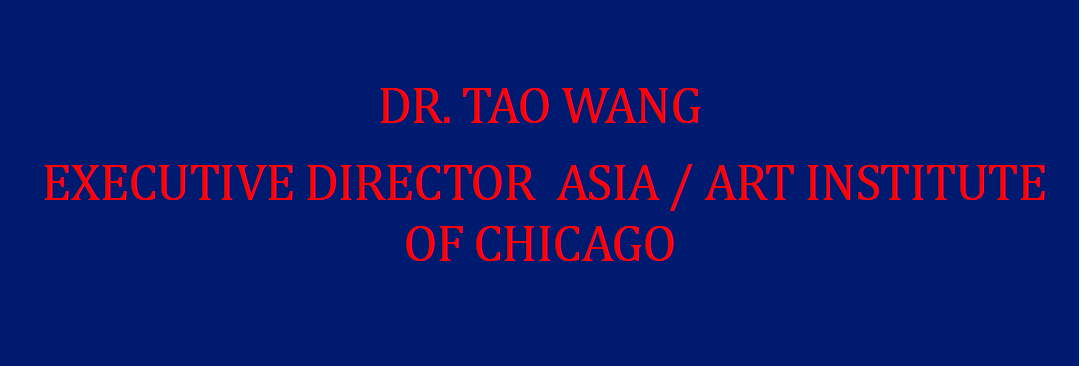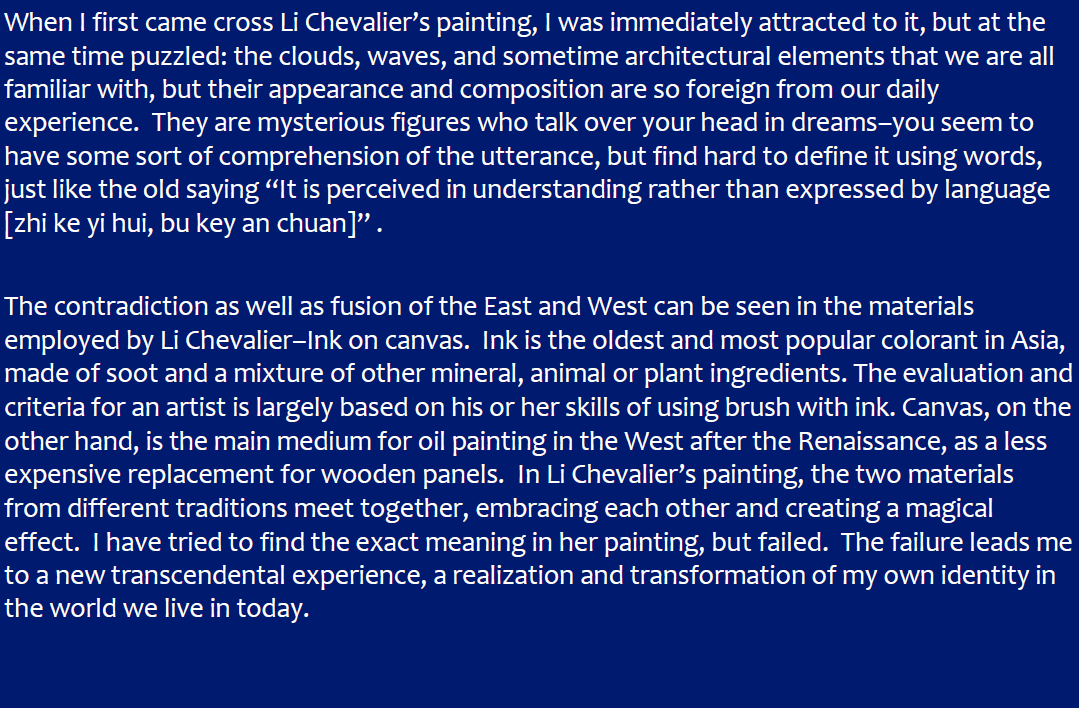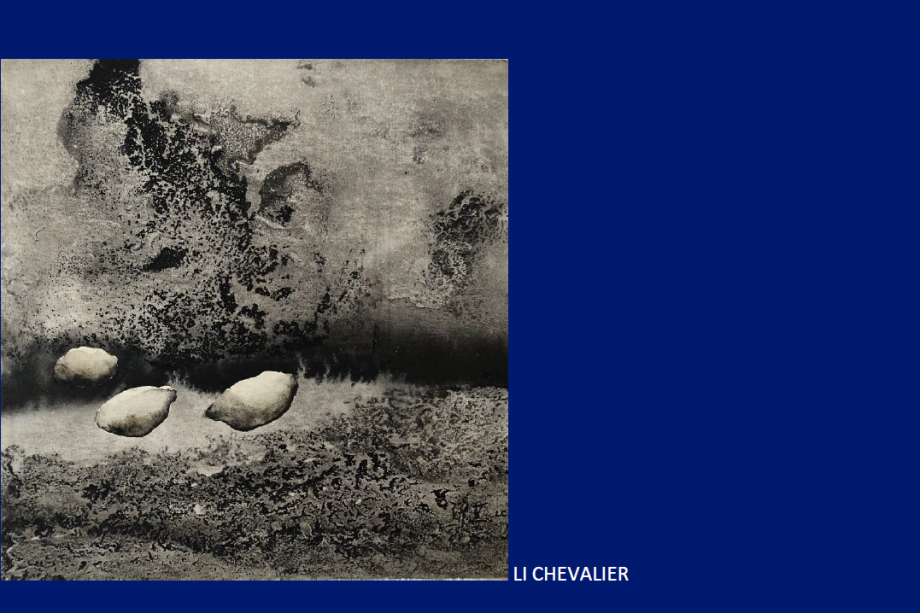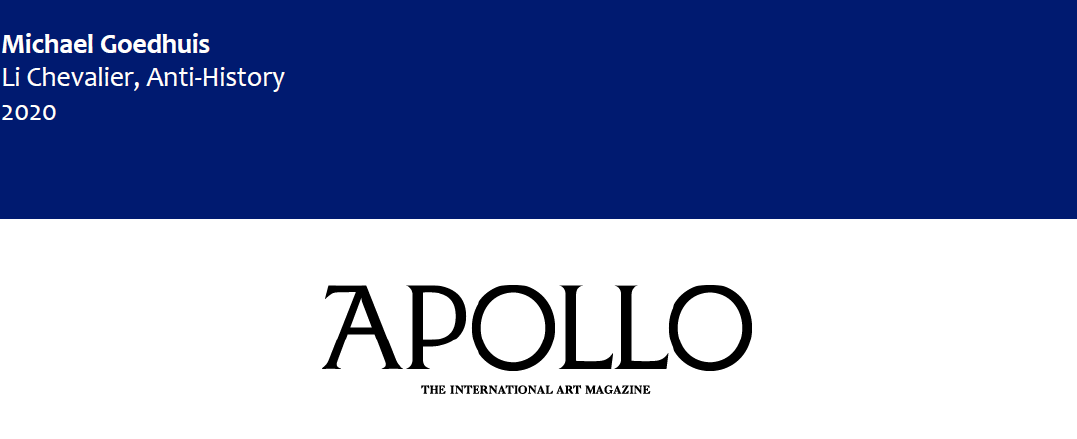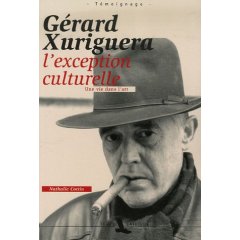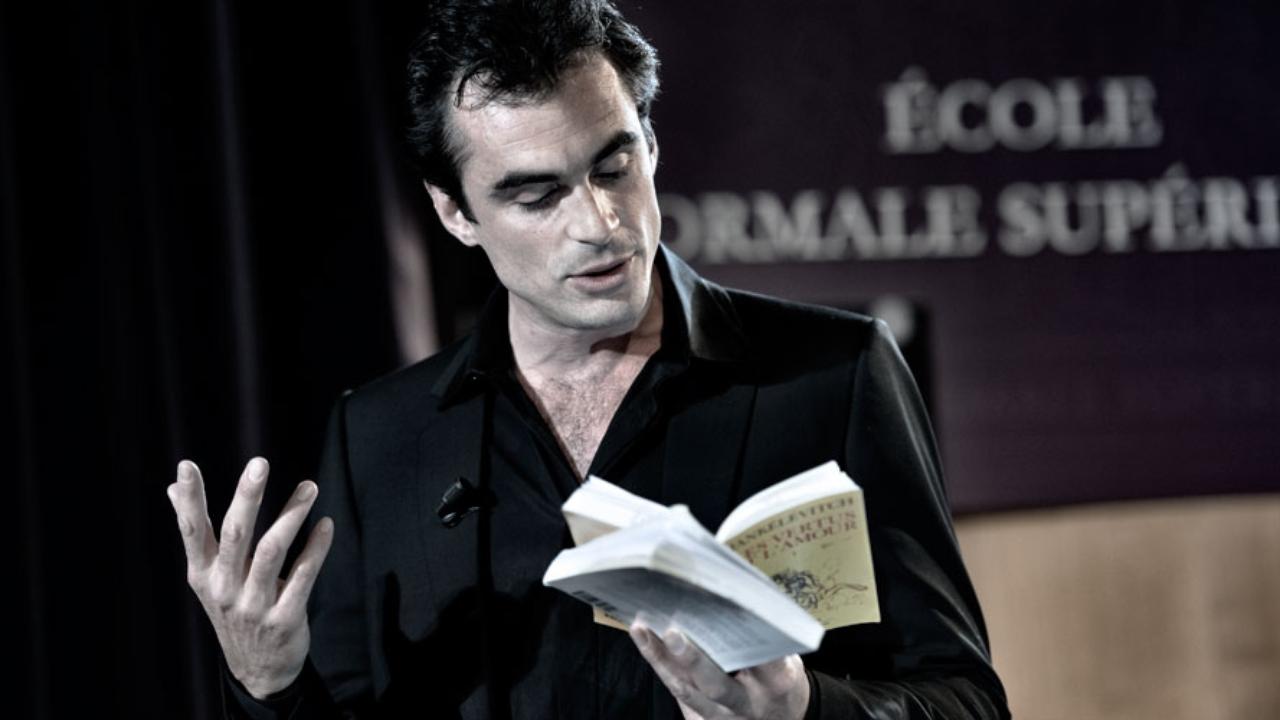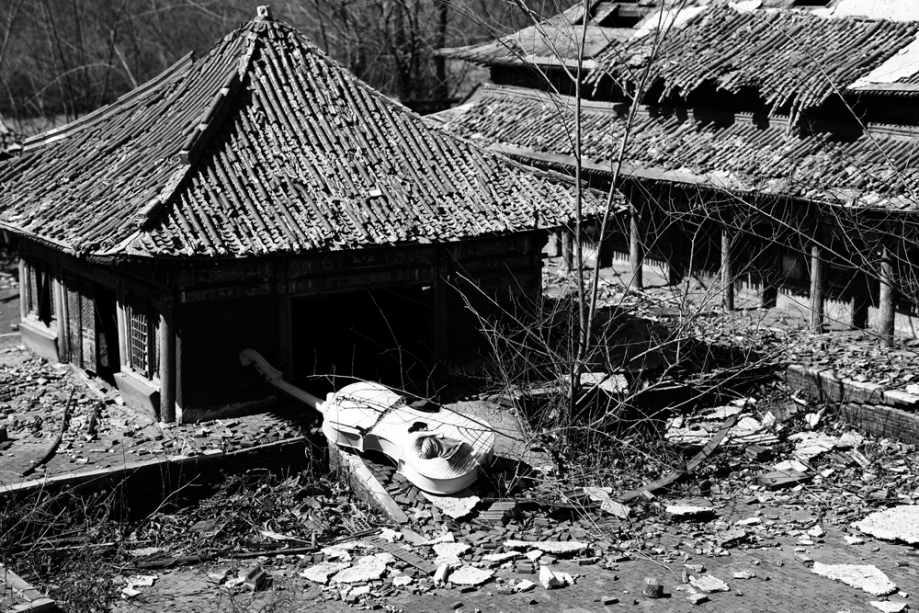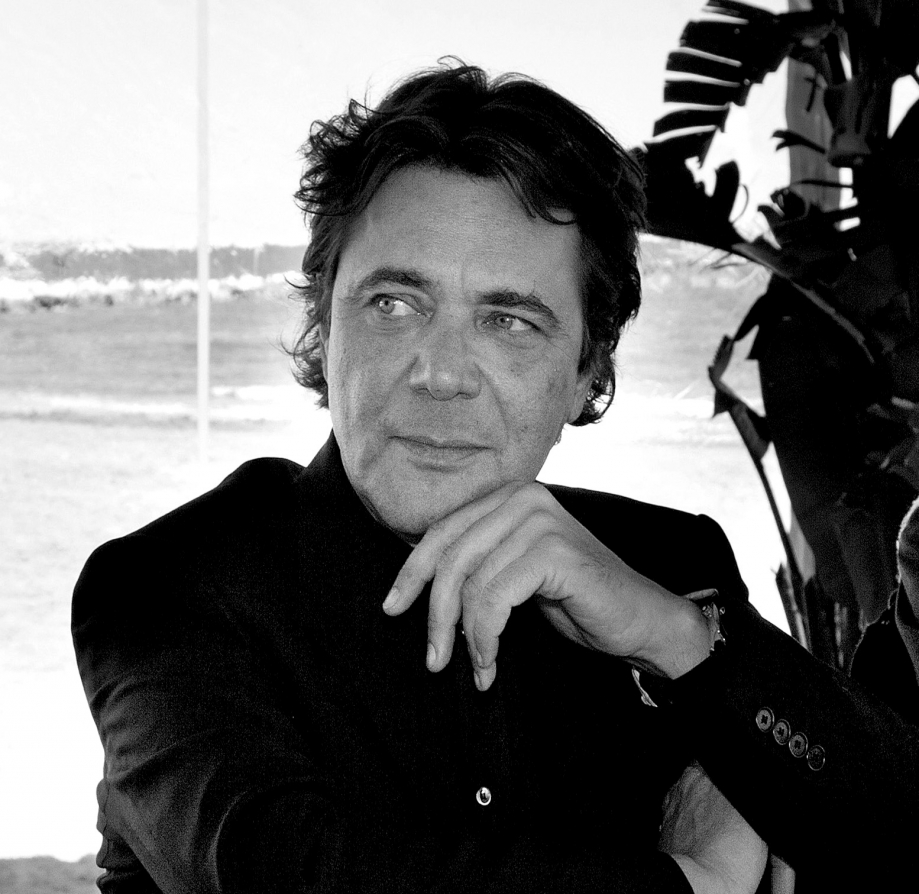Art critics
Critic by Gérard Xuriguera
SHE HAS CREATED A WORLD OF HER OWN
Franco-Chinese or Sino-French, Li Chevalier uses Chinese ink in an unprecedented way, creating dark, torn landscapes, set against backgrounds crossed by chalky flushes and minute sparkles that spawn nocturnal vibrations and recurrent spatterings, originating in what Toshimitsu Imai calls « controled accident ». The field of vision flares out, flickers and then narrows down toward mineral, or sometimes sidereal, zones, beneath the never premeditated assaults of the ink, often intertwined with acrylic, sand or collages, which the thinking hand of the artist orchestrates in a gestural round dance blushed with contained effervescence. At times, a vague silhouette emerges from an uncertain mist, or a solitary Christian cross bent over by the breeze, as in Breton pilgrimages. At other times, an aquatic impression, or one of volcanic magma, emanates from beneath the material, while at the same time, a sort of deaf and moving abstraction shows through, striped with delicate creases and phosphorescent glimmers that evoke almost menacing climates, but wherein reigns, primarily, an atmosphere or a presence. There is a kind of melancholia, a fallacious distance, but above all, true mastery. These grave and secret images are essentially evocatory, they refer to nature, but a quintessentialized nature, which belongs solely to its author. Li Chevalier has not given in to the temptation of drawing a bridge between East and West : she has created a world, a world of her own.
Critic by Raphael Enthoven
THE MEMORY OF A SONG
Socrates was a strange man.
Rich but poorly dressed, polite but not punctual, hideous yet sublime, the father of dialectics was sometimes prone to blindly obeying the whims of a demon, or of a « dream », which, acting as a benine genie, would order him, let's say, to lie down in the shade of an apple tree or, despite his imminent execution, to become a musician. « Socrates ! Become a poet and cultivate music ! » What next?
« Up until now, he confessed in Phaedo, I thought that... in the same way we encourage athletes, the dream spurned me on to pursue my occupation, to practise music ; because to me, philosophy is the loftiest music, and the object of my pursuit. But now that my trial has taken place and that the god's celebration has postponed my death, I thought that perhaps, if the dream ordered me to take up ordinary music, I should not disobey it and should do so... »
A strange urgency. What is the point of becoming a real musician, at this point ?
Why have spent one's life preparing for death (namely by detaching the soul from the body through reflection) only to plunge into affect when the time has come to die ?
But why, conversely, under the pretext that darkness is extending its weight, yield a single inch of terrain to death, while still among the living, and not do exactly what we feel like doing, singing whatever tune we wish to sing?
Is the man whom the nearing abyss leads to begin practising music a madman untouched by reality, or a sage who, here as elsewhere, offers reality no grip ? « One does not learn to die, assures Jankelevitch ; one does not prepare for what is of an entirely different order. What death requires is a preparation without preparations... » Indeed. Time is short. Let us take our time.
Some people practise dying by disavowing their perceptions or by preparing for a possibly long journey. Others (wiser and less foresighted) recognise that life ITSELF does not cease with theirs, and that what is at stake is not surviving their own death, but organizing the happiness of those who will survive them. The first separate the body from the soul, in the same way as a melody escapes from a lyre. The others face up to finitude and mortality, in the same way as a violin left abandoned, a ruin among the ruins of dawn.
Between hope and joy – or between those who desert and those who do not fear the desert - , Li Chevalier has made her choice.
She sides with a form of nostalgia, which has outpaced for ever the certainty of having lost the time and place she pines for. And of a soul whose memories, full of wonder and sadness, discourage one from changing skins.
Here below, heirless instruments, future stones, are already stripped of their strings, legs, and inner song. Rondo logs, the wood of violins merges slowly with dregs of ivory. It happens not unseldom that their crumbled backs offer meager asylum to a man struggling against the wind, or to the muted organ pipes of stalagmites, with a phenix as a backdrop.
Everything seems to speak of death and arrested impetus.
When Li speaks of music, her eyes are dry for having cried too much.
Yet she has offered others a gift of abandon.
And it does happen, now and again, if you listen carefully, that in contemplating her corpses still warm, and feeling the heat dying down, you may hear, in a whisper, the arpeggios of a mineral melody, the lost dream of a well-behaved child – just as Camus, after having dehumanized the world and returned all things to their primordial silence, catches a glimpse of the sky's first smile on an autumn morn in Florence.
It is the distraught idol of a melodious heart. The anamnesis of an intuitive knowledge.
Curbing regret by examining its cause.
Cherishing one's sadness as a living source.
The memory of a song.
Critic by François Jullien
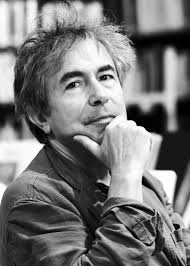
Here and there, shapes sporadically begin to appear, minimally, emerging out of the surrounding non defined-ness, standing firm and at times even sharp.
Is this a portico, some sort of Japanese tori serving as a threshold? But where does it lead to? To one of these three interconnected arms? Or is it the Greek pi π, expressing incommensurability, defying rationality?
The outline stands out naked, elemental, yet is not symbolic. It indicates that something is taking place, is emerging, has begun its individuation; it keeps our attention in suspense without contenting it.
Lonely, scattered, slender yet firm, these three poles tear us away from the opacity of things, but they do not constitute a sign: rather than inhabiting the landscape, they enhance its emptiness and make its forlornness tangible.
Between « there is » and « there isn’t», you wu zhi jian 有无 之閒
This protrusion underlines the diffuse blandness surrounding it: all is smooth, the eye glides by, diving into indifferentiation.
Either some form of granulation seeps through to the surface, here and there, and begins to catch the eye – a hint of movement, a stretch of foam. But no form encloses this asperity, neither lends it contours nor leads it toward figuration.
Or a line appears from without, detaching itself from an abstract stroke, withdrawing into itself almost elliptically, like a burst of light: its flattened out circle surrounds, enhances, leads our attention toward something, but we don’t know what.
Because the ink saturates, leaving things evasive. Thus, that which emerges and is hinted at is not symbolic; as I have said, it does not open space for interpretation, it is allusive : it calls out to another dimension, but does not cut all ties with the sensitive world. It leads to a disadherence, which does not convert the eye, does not direct it toward an intelligible world.
« Landscape beyond landscape », jing wai jing 景外景, in Chinese; or “taste beyond taste”, wei wai wei
味外味.
The power, or rather, the readiness of ink; ink opens up betweenness and lets things through, indefinitely.
By varying continuously, by waning and regaining life, by darkening or diluting, it lets things through, allows them to diffuse and impregnate.
Thus, instead of capturing an essence, thanks to its substance, instead of building meaning through figuration, as painting has so often striven to do, it dissolves figuration and allows it to emanate.
It makes us dream of elsewhere, but an elsewhere that arises from within, spreads from within. Infinity is no longer folded into a “Heaven”, yonder, behind its horizon, creating a separation – but unfolds out of the diluted.
ENTRE IL Y A - IL N'Y A PAS
Des formes s’esquissent, çà et là, sporadiquement, minimalement, émergeant de l’indéfinition d’alentour, se campant fermes et même parfois acérées.
Est-ce un portique, quelque tori japonais faisant seuil – mais vers quoi ? – de ces trois bras raccordés ? Ou bien est-ce là le pi π grec de l’incommensurable, défiant la rationalité ?
Ce tracé qui se détache est nu, élémentaire, mais n’est pas pour autant symbolique. Il signale que quelque chose a lieu, émerge, a commencé de s’individuer, maintient l’attention en suspens, mais sans pourtant la contenter.
Esseulés, épars, graciles, mais fermes à la fois, ces trois poteaux font décoller de l’opacité des choses, mais ils ne font pas signe : au lieu de meubler le paysage, ils le rendent déshabité, font éprouver son esseulement.
Entre « il y a » - « il n’y a pas », you wu zhi jian 有无 之閒
Ce saillant fait ressortir le diffus, la fadeur d’alentour, où tout est lisse, sur quoi le regard glisse, plongeant dans l’indifférencié.
Ou bien quelque granulation monte à la surface, ici et là, à quoi la vue commence d’accrocher – début de moutonnement ou trait d’écume. Mais aucune forme n’enferme cette aspérité, ne la borde et ne la destine à la figuration.
Ou bien alors la ligne intervient du dehors, se détachant d’un trait abstrait, se repliant sur lui-même, quasiment elliptique, tel un jet de lumière : elle entoure de son cercle aplati, fait ressortir, désigne à l’attention, mais on ne sait pas quoi.
Car l’encre, en imbibant, laisse évasif. Aussi ce qui émerge et qui s’esquisse est-il, non pas symbolique, donnant à interpréter, je l’ai dit, mais allusif : appelant vers un au-delà, mais qui ne rompt pas avec le sensible ; portant à une désadhérence, mais qui ne convertit pas le regard, ne le tourne pas vers un monde de l’intelligible.
« Paysage d’au-delà le paysage », jing wai jing 景外景, dit le chinois ; ou « saveur d’au-delà la saveur », wei wai wei 味外味.
Pouvoir, ou mieux, disponibilité de l’encre : l’encre ouvre de l’entre et laisse indéfiniment passer.
En variant continûment, en s’estompant et s’avivant, se fonçant ou se diluant, elle laisse passer à travers, se diffuser et imprégner.
Au lieu donc qu’elle cerne une essence par sa matière, qu’elle édifie du sens par sa figuration, comme l’a tant voulu la peinture, elle dissout la figuration et la laisse émaner.
Elle fait rêver d’un ailleurs, mais qui se dégage de l’intérieur, se répand du dedans. L’infini n’est plus replié dans un « Ciel », retranché derrière sa ligne d’horizon, formant séparation – mais se déploie du dilué.
Critic by Paolo De Grandis
ART OF CONNECTIONS AND INTERCONNECTIONS
I have always been fascinated by Oriental art in its many aspects, from classical Chinese and Japanese art to contemporary art, which today occupies a strong position on the international scene, to the art of calligraphy, which I find of sublime expression. From the beginning of my career I have traveled with passion to discover these distant worlds with the desire to offer new opportunities to contemporary oriental artists in our country. This research started in the 1980s through numerous collaborations with Asian artists, museums and foundations and has never stopped. It has culminated at the MACRO - Museum of Contemporary Art in Rome, with the project <From the Biennale di Venezia & OPEN to the MACRO, International Perspectives>, organized with Claudio Crescentini. This project is the extension of <OPEN, International Exhibition of Sculpture and Installations> that I launched with Pierre Restany in 1996 with the precise aim of creating an open-air exhibition of sculptures and installations coinciding with the Venice Film Festival and the Biennale. Over the years, OPEN has developed into a vast exploration of sculpture, which has intentionally extended to the field of installation.
Along the way, I met Li Chevalier, an extraordinarily talented artist whose works are so unique that it is not possible to classify them or label them in any way. They must simply be "exposed" and in what frame more appropriate than MACRO, where the Franco-Chinese artist presents a project full of the refined grace that characterizes her work. Li Chevalier pursues a plastic research where aesthetics is cherished and reveals the truth of the world. It is marked by the elegance and refinement of the pictorial technique and the staging in her installations.
When Li Chevalier leaves Beijing for Paris, her art reaches a new dimension where the Chinese tradition is nourished by a Western philosophical-aesthetic context that never completely absorbs it, but which influences it, making it more articulated. Her aesthetics of the void "fills" with new elements, which modify, fertilize and nurture her work
Another constant interest in the life of Li Chevalier is music that she has grown with in China since the age of 15 years. She then sang as a soprano at the Choir of the Paris Orchestra conducted by Arthur Oldham and Semyon Bychkov. She was accompanied by the soloists of the Paris Opera in many musical-visual events, including a premiere at the National Opera of China under the direction of Philippe Jordan, where violin solo Frédéric Laroque gave an impromptu in front of her monumental installation.
This passion for music gives her installations a singular expressive timbre. Her productions reinterpret deeply the space, regenerate it, and create a dynamic landscape where one is immersed. The spectator moves in an enveloping space where light and shade, undulating water, wind breezes and the sounds of stringed instruments scarcely touch the precious and delicate art works : the ink worthy of the most beautiful classic technique, the dream landscapes, ally to reveal signs and stories. The finely painted violins are in harmony with fluctuating veils of ideograms, the black of the ink calls our gaze, enchanting and tracing "the trajectory of desire".
Her paintings maintain the purity of tradition, emerging from the sands, mists and the distant horizons. The sails of fine calligraphy evoke the spontaneous breath of Oriental creation while violins and music invade the space generating a poetic symphony with Western accents. In this meeting between East and West, an intercultural experience, an art of connections and interconnections, cross-education and mutual discovery, a unique artistic experience flourish. Her aesthetic universe, both complex and immediate, requires no analysis and captures us without mediation. The art of Li Chevalier is suggestion: tales of love, travelers, children, faith, nostalgia, choice. She reveals the sketches of a bridge, a woman, long hair, a cross, trees, a circle ... of Time.

